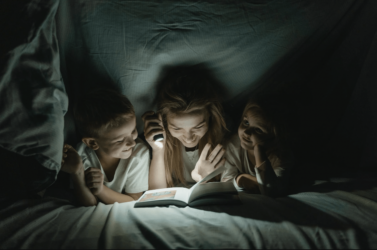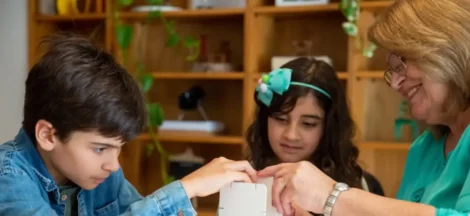In today’s fast-paced digital age, personalized storytelling has become an influential and captivating way to engage with an audience. Through the use of custom art, storytellers can create unique and unforgettable experiences that resonate deeply with viewers. In this article, we will explore the concept of personalized storytelling, and the role of custom art in this process, and provide essential tips and techniques for effectively conveying stories through art.
Understanding the Concept of Personalized Storytelling
Personalized storytelling is the art of tailoring the narrative to individual preferences, interests, and experiences. It goes beyond the traditional forms of storytelling by directly involving the audience in the creation and interpretation of the story. Custom art, in this context, becomes the medium through which the story is brought to life, enabling a deeper connection between the storyteller and the audience.
Imagine a world where every story you encounter is uniquely crafted to resonate with your personal tastes and experiences. Personalized storytelling takes storytelling to a whole new level, offering an immersive and engaging experience that is tailored specifically for you. It’s like stepping into a magical realm where the story unfolds in a way that captivates your mind and touches your heart.
The Power of Custom Art in Storytelling
Custom art allows storytellers to express their ideas and emotions in a visually captivating way. It creates a unique atmosphere that transports the audience into the world of the story, making them active participants in the narrative. Whether it’s through paintings, illustrations, or multimedia installations, custom art has the ability to evoke powerful emotions and provoke thought, making the story more memorable and impactful.
Imagine walking into an art gallery where each painting tells a story that is intricately woven with your own experiences and interests. The colors, the brushstrokes, and the composition all come together to create a visual masterpiece that speaks directly to your soul. As you stand in front of the artwork, you can feel the emotions emanating from the canvas, drawing you deeper into the story and leaving a lasting impression.
The Role of Personalization in Art
Personalization plays a vital role in the success of custom art storytelling. By tailoring the artwork to reflect the individuality and experiences of the audience, storytellers can establish a personal connection, sparking intrigue and capturing attention. Incorporating elements such as names, symbols, or personal anecdotes into the art creates a sense of intimacy, drawing the audience deeper into the story and forging a stronger emotional bond.
A prime example is a family portrait painting, where the canvas becomes a conduit, capturing generations of love, shared laughter, and enduring bonds. It’s not just about replicating faces, but encapsulating the heartbeats of familial narratives. This powerful blend of artistry and personal storytelling is exemplified by Memorialize Art. Their dedication to creating personalized artwork offers clients a platform where their stories aren’t just told; they are celebrated, and transformed into timeless pieces that stand as visual memoirs, echoing tales of love, triumph, and life’s cherished moments.
Essential Tips for Personalized Storytelling through Art
To effectively convey personalized stories through custom art, consider the following tips:
- Choosing the Right Medium for Your Story
The medium you choose for your custom art should align with the narrative you want to convey. Each medium has its unique strengths in evoking specific emotions and resonating with different audiences. Whether it’s a painting, sculpture, or digital artwork, selecting the appropriate medium will enhance the impact of your storytelling.
- Incorporating Personal Elements into Your Art
To create truly personalized art, incorporate elements that are meaningful to the individuals experiencing the story. This could be their names, favorite symbols, or personal stories that evoke a strong emotional response. By infusing these elements into your art, you create a sense of ownership and personal connection in the minds of the audience.
Techniques for Creating Custom Art
Creating custom art requires a combination of creativity and technical skills. Here are some techniques to help you bring your personalized storytelling to life:
- Mastering the Art of Visual Storytelling
Visual storytelling is about conveying emotions and messages through imagery. Experiment with different visual techniques, such as composition, color schemes, and perspective, to create a captivating visual narrative that engages the audience and enhances the overall story.
- Techniques for Adding Personal Touches
Personal touches can be added to your art through various techniques. For example, you can incorporate hand-drawn elements, collage personal photographs, or even integrate interactive elements, like augmented reality or QR codes, to create a truly immersive and personalized experience for your audience.
Overcoming Challenges in Personalized Storytelling through Art
Despite the rewards of personalized storytelling, some challenges may arise. Here’s how to overcome them:
- Dealing with Creative Blocks
Creative blocks are a common obstacle for artists. When faced with a creative block, try stepping away from the project for a while, seeking inspiration from other art forms, or collaborating with other artists. Remember, creativity thrives when we allow ourselves to explore new ideas and perspectives.
- Ensuring Your Story is Effectively Communicated
Communication is key when it comes to personalized storytelling through art. Pay attention to how your audience reacts to your art and make adjustments accordingly. Seek feedback and take the time to understand how your art is being perceived to ensure that your intended message is effectively communicated.
The Impact of Personalized Storytelling on Audience Engagement
Personalized storytelling through custom art has a profound impact on audience engagement. By actively involving the audience in the narrative, customized art forms create a sense of connection and relevance, capturing the viewer’s attention and triggering an emotional response.
- How Personalized Art Captivates the Audience
Personalized art captivates the audience by making them feel seen and understood. When the story is tailored to their interests and experiences, viewers are more likely to invest their attention and emotionally connect with the narrative. This engagement fosters a sense of belonging and encourages a deeper exploration of the story being told.
- The Emotional Connection in Personalized Storytelling
Personalized storytelling evokes powerful emotions in the audience. By weaving personal elements into the art, the storyteller can tap into the viewer’s memories, nostalgia, or aspirations, eliciting a more profound emotional response. This emotional connection strengthens the bond between the audience and the artwork, creating a lasting impact on their perception and memory of the story.
Takeaway
Personalized storytelling through custom art is not just an artistic venture but a voyage into the heart’s deepest corridors, capturing tales that resonate on a profound level. In mastering the concept of personalized storytelling, coupling it with the magic of custom art, and applying nuanced techniques, we bridge the gap between the storyteller, the audience, and the very fabric of the narrative.
But to truly elevate this experience, a touch of mastery is crucial. This is where Memorialize Art shines brightly, offering an unparalleled canvas for your tales to come alive. As you unleash your creativity, allow Memorialize Art to be the guiding hand, ensuring every story doesn’t just get told but is immortalized with finesse, leaving an indelible mark on all who behold it.





 6 Christmas Dessert Recipes to Sweeten Your Celebrations
6 Christmas Dessert Recipes to Sweeten Your Celebrations